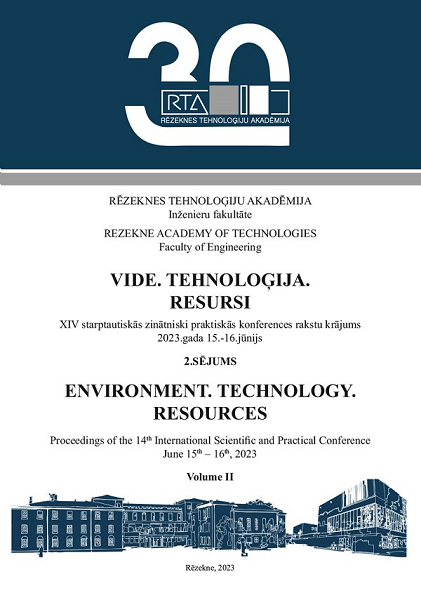READINESS OF LATVIA’S ORGANIZATIONS FOR ADVANCED ANALYTICS
DOI:
https://doi.org/10.17770/etr2023vol2.7256Keywords:
advanced analytics, analytics maturity, analytics maturity assessmentAbstract
The advanced analytics is one of the core tools to provide competitive advantage, sustainable development and foster productivity of the organization. Digital transformation and advanced analytics are two key trends in the emerging age of data, analytics, and automation. Digital transformation is the process of transforming how businesses operate when faced with digital disruption. Advanced analytics is the application of predictive and prescriptive models to analyse large, complex datasets in order to make critical business decisions. The focus of the paper is to assess the maturity level of advanced analytics in the organizations of Latvia by region, size and industry. Assessment was done by several domains like Organization, People, Data, Analytics, Technologies. The quantitative online survey was performed to assess the readiness of Latvia’s organizations for advanced analytics. The questionnaire was developed based on an academic literature review, reports and publications by researchers, analytical sector, industry experts and Author’s professionals experience in advanced analytics industry. The overall readiness level of Latvia’s organizations is 2.4 in 5 points scale. It differs by region, size of the organization and industry. Most of organizations do not have Analytics strategy, majority use spreadsheets based analytical tools, half of organizations use mostly only internal data, more than third part of organizations do not have any analytical resources. It leads to conclusion that majority of Latvia’s organizations are far from ability to improve productivity, be able to maximize the potential of the digital environment, to exploit data to make data-driven and automated decisions and are far from 21st century digital opportunities. Thus, puts under danger the sustainability of the organizations itself.
References
OECD iLibrary, “Going Digital in Latvia”, 2021. [Online]. Available: https://www.oecd-ilibrary.org/sites/e341ffed-en/index.html?itemId=/content/component/e341ffed-en#sec-13 [Accessed: Jan 21, 2023].
European Commission, “Regional Policy”, 2021. [Online]. Available: https://ec.europa.eu/regional_policy/policy/how/priorities_en [Accessed: Feb 10, 2023].
OECD economic departmnet working papers No.1571, “Policies for stronger productivity growth in Latvia”, 2019. [Online]. Available: https://read.oecd-ilibrary.org/economics/policies-for-stronger-productivity-growth-in-latvia_fe4ffc2b-en#page4 [Accessed: Feb 10, 2023].
Oxford Languages, Definitions, [Online]. Available: https://www.google.com/search?q=analytics+definition&sxsrf=APwXEdeF1TNI1tk0UZc4MPR_bXpW0g-6MA%3A1682167314220&ei=EtZDZJqQDb-QwPAP-N2y4AE&ved=0ahUKEwia4d3Jwb3-AhU_CBAIHfiuDBwQ4dUDCBA&uact=5&oq=analytics+definition&gs_lcp=Cgxnd3Mtd2l6LXNlcnAQAzoKCAAQRxDWBBCwA0oECEEYAFC-AlijKWDMNGgBcAF4AIAB5wGIAZMLkgEGMC4xMC4xmAEAoAEByAEIwAEB&sclient=gws-wiz-serp [Accessed: Apr 22, 2023].
Oxford Languages, Definitions, [Online]. Available: Oxford Langugaes, Definitions, [Online]. Available: https://www.google.com/search?q=ecosystem+definition&sxsrf=APwXEdfaRP-QdgwtZZzbf6OAISTYVgyZ4w%3A1682167326207&ei=HtZDZLHxC4f9rgTcz6zoDw&ved=0ahUKEwix-LjPwb3-AhWHvosKHdwnC_0Q4dUDCBA&uact=5&oq=ecosystem+definition&gs_lcp=Cgxnd3Mtd2l6LXNlcnAQAzIECCMQJzIGCAAQBxAeMgYIABAHEB4yBggAEAcQHjIGCAAQBxAeMgYIABAHEB4yBggAEAcQHjIGCAAQBxAeMgYIABAHEB4yBggAEAcQHjoKCAAQRxDWBBCwAzoICAAQBxAeEA86BwgjELACECdKBAhBGABQow1Y7BlgvidoBHABeACAAX-IAcUHkgEDMi43mAEAoAEByAEDwAEB&sclient=gws-wiz-serp [Accessed: Apr 22, 2023].
A. Gandomi and M. Haider, “Beyond the hype: Big data concepts, methods, and analytics,” International Journal of Information Management, vol. 35, pp. 137–144, 2015.
C.V. Apte, S.J. Hong, R. Natarajan, E.P.D. Pednault, F.A. Tipu and S.M. Weiss, “Data-intensive analytics for predictive modeling,” IBM Journal of Research & Development, vol. 47 (1), pp. 17-23, 2003.
Portulans Institute, “The Network Readiness Index 2022,” 2022. [Online]. Available: https://networkreadinessindex.org/ [Accessed: Apr. 22, 2023].
Ministry of Education and Science. (2014-2018). “Viedās specializācijas stratēģijas monitorings”, 2020. [Online]. Available: https://www.izm.gov.lv/lv/media/5998/download?attachment [Accessed: Jan. 19, 2023].
Ministry of Education and Science. 2020. “Zinātnes, tehnoloģijas attīstības un inovācijas pamatnostādnes 2021. – 2027. gadam”, 2020. [Online]. Available: https://www.izm.gov.lv/lv/media/11501/download?attachment [Accessed: Apr. 22, 2023].
J. Piyanka, “The Analytics Maturity Quotient Framework,” 2019. [Online]. Available: https://aryng.com/download/consulting-downloads/Aryng_-_Data_Culture_Assessment.pdf [Accessed: Mar. 22, 2021].
T.H. Davenport, “DELTA Plus Model & Five Stages of Analytics Maturity: A Primer,” International Institute for Analytics, 2018. [E-book] Available: https://www.iianalytics.com/delta-plus-primer/. [Accessed Mar. 20, 2021].
J. Lismonta, J. Vanthienen, B. Baesens and W. Lemahieua, “Defining analytics maturity indicators: A survey approach,” International Journal of Information Management, vol. 37, pp. 114-124, Jun. 2017. [Online]. Available: https://www.sciencedirect.com/science/article/pii/S0268401216305655. [Accessed October 18, 2020], https://doi.org/10.1016/j.ijinfomgt.2016.12.003
F. Halper, “TDWI Analytics Maturity Model. Assessment Guide”, 2020. [Online]. Available: https://tdwi.ilumivu.com/org_tdwi/media/other/TDWI_Analytics_Maturity_Model_Assessment_Guide_web.pdf. [Accessed: Mar. 22, 2021].
Oficial statistics portal, “Number of enterprises and enterprise demography”, 2021. [Online]. Available: https://stat.gov.lv/lv/statistikas-temas/uznemejdarbiba/skaits-demografija [Accessed: Dec 15, 2021].
Investment and Developemnet Agency of LAtvia, “Mazā, vidējā komersanta statusa noteikšana”, 2020. [Online]. Available: https://www.liaa.gov.lv/lv/programmas/noderigi/maza-videja-komersanta-statuss?utm_source=https%3A%2F%2Fwww.google.com%2F [Accessed: Sep 30, 2022].
Procurement Monitoring Bureau Republic of Latvia, “Skaidrojums par mazajiem un vidējiem uzņēmumiem”, 2017. [Online]. Available: https://www.iub.gov.lv/lv/skaidrojums-mazie-un-videjie-uznemumi?utm_source=https%3A%2F%2Fwww.google.com%2F [Accessed: Sep 30, 2022].
An official website of the European Union, “Commission Recommendation of 6 May 2003 concerning the definition of micro, small and medium-sized enterprises”, 2021. [Online]. Available: https://eur-lex.europa.eu/eli/reco/2003/361 [Accessed: Sep 30, 2022].
Central Finance and contracting agency Republic of Latvia, “Informatīvs materiāls par mikro, mazā un vidējā uzņēmuma, viena vienota uzņēmuma un grūtībās nonākuša uzņēmuma statusa noteikšanu”, 2022. [Online]. Available: https://www.cfla.gov.lv/lv/media/2946/download [Accessed: Dec 9, 2022].
Legal Acts of the Republic of Latvia, “Par Latvijas Republikas statistiskajiem reģioniem un tajos ietilpstošajām administratīvajām vienībām”, 2021. [Online]. Available: https://likumi.lv/ta/id/328252-par-latvijas-republikas-statistiskajiem-regioniem-un-tajos-ietilpstosajam-administrativajam-vienibam [Accessed: Dec 15, 2021].



